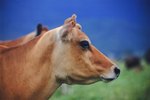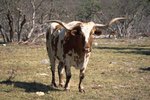
A bull and a steer, while both male bovine, are not the same critter. Aside from key anatomical differences, bulls and steers vary from each other in how aggressive they are toward humans and other members of their herd. Their uses by humans working in the cattle industry also differ.
Reproductive Difference
Bulls are male bovines that are capable of mating and reproduction as their testicles have not been removed. A steer, still a male bovine, is a bull that has been castrated. His testicles have been removed, while his penis and its sheath remain intact. Bovine castration is done most commonly long before sexual maturity when the bull is a young calf. As one bull can service many cows, only male bovines with the best genetics are left fully intact. Steers are used for meat production -- a task not requiring testicles.
Other Physical Differences
Because most steers were cut -- or had testicles removed -- at a young age, their bodies develop differently than do bulls. The muscular crest over the neck and shoulders of a bull is not present on a steer. Within a herd setting, bulls are more easily identifiable as such versus steers, whose bodies and muscular development are more similar to female bovine other than the presence of a penis. The hairy prepuce in the middle of a steer's underbelly covering the sheath housing his penis is less bushy and the sheath itself is less pronounced.
Behavior Difference
The removal of testicles causes a reduction in testosterone production. Testosterone, a sex hormone, not only drives male mammals to copulate, it also makes them more aggressive. In general terms, a steer is a more docile bovine and does not cause fights within his herd because he is not competing for the females according to South Dakota State University. In contrast, bulls are continually aware of when female bovine are in estrus, thus seeking constant dominance over the herd. This aggressive behavior can transfer to their relationship with humans if they perceive people as a threat to their control of the herd and its females. A bull is more likely to charge a human than is a steer.
Meat Production Difference
Bulls are larger than steers and, therefore, their carcasses post slaughter produce more edible meat than do those of steers. The Journal of Animal Science reports that a bull carcass produces anywhere from 10 to 20 percent more meat compared to a steer carcass. This higher yield applied to all cuts obtained from the carcass, but was significantly greater in the rib eye cut, popular for its juicy flavor, which comes from the upper rib section.
References
- Difference Between: Difference Between Bull and Steer
- Journal of Animal Science: Bulls Versus Steers. I. Carcass Composition, Wholesale Yields and Retail Values
- Cows R Great!: Telling the Difference Between Bulls, Cows, Steers and Heifers
- South Dakota State University: Beef Cattle Procedures -- Castration
Resources
Photo Credits
-
Jupiterimages/Photos.com/Getty Images
Writer Bio
Amy M. Armstrong is a former community news journalist with more than 15 years of experience writing features and covering school districts. She has received more than 40 awards for excellence in journalism and photography. She holds a Bachelor of Arts in communications from Washington State University. Armstrong grew up on a dairy farm in western Washington and wrote agricultural news while in college.




